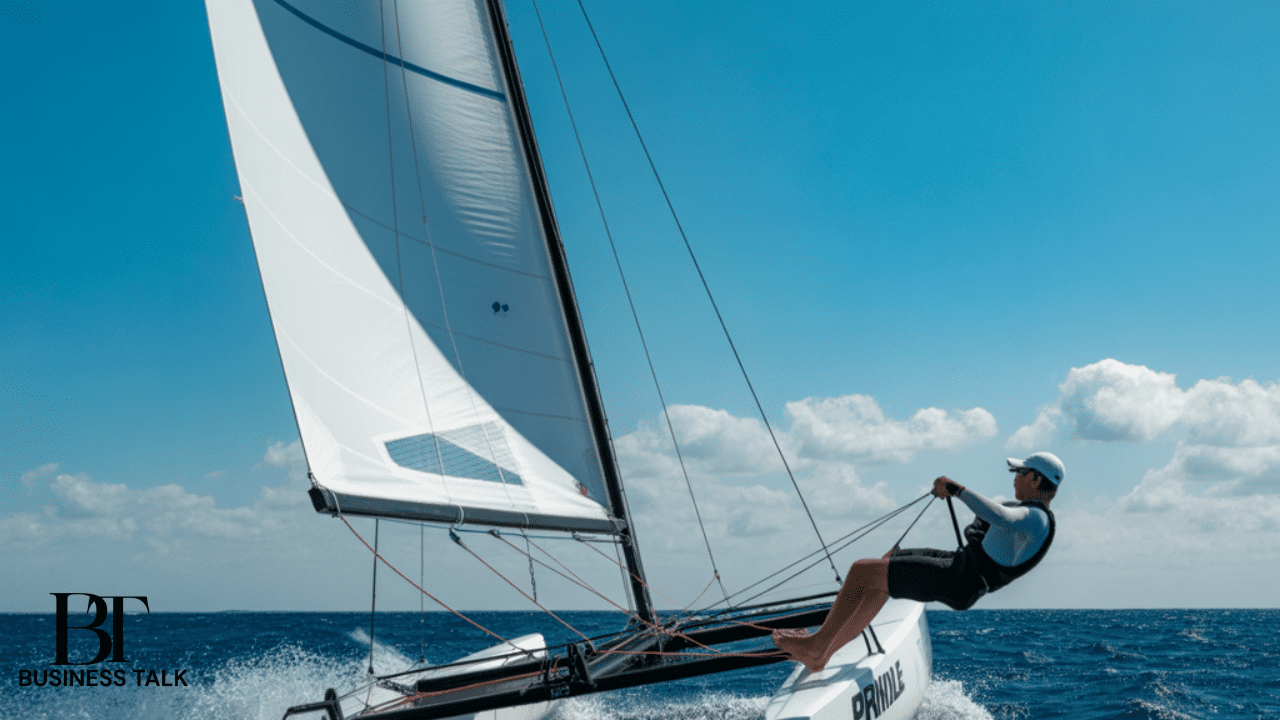Sailing enthusiasts across the United States know that when you mention the term Prindle 16 Traveller, you’re referring to a classic and enduring design of small beach catamaran that blends spirited performance with accessible handling. From its beginning as a design by Geoffrey Prindle to the many units that found their way into the hands of weekend sailors and club racers, the Prindle 16 Traveller remains a standout in the beach catamaran world. This article will explore the design’s history, performance characteristics, suitability for the U.S. sailing market, and why it continues to hold relevance today despite advances in multihull technology. If you’re in the market for a fun, manageable, fast beach cat, the Prindle 16 Traveller deserves your attention.
The Legacy of the Prindle 16 Traveller
The story of the Prindle 16 Traveller starts with Geoffrey Prindle, a surfer-turned-catamaran designer. According to records, the original model known simply as the Prindle 16 was first built in 1971, with some 9,000 units produced. The “Traveller” appellation typically refers to a variant suited for day sailing and accessible use rather than pure racing. It adopted many of the features that made Prindle’s design stand out: a lightweight fiberglass-foam sandwich hull construction, twin hulls (catamaran) form, and a rig designed for agility and responsiveness.
One of the notable design improvements of the Prindle over earlier beach cats was its enhanced bow buoyancy, which helped reduce the so-called “pitch-poling” or burying of the bow that many small cats suffered. The design’s improved forward volume gave the Prindle better control when surfing or reaching.
Whereas many catamarans are optimized for pure racing or high-performance maneuvers, the Prindle 16 Traveller targets a broader audience. It offers a platform that is both fun and forgiving: capable of speed and responsiveness, yet manageable for sailors who are not solely focused on winning regattas. This duality is part of its enduring appeal, as the Traveller variant allows for casual day-sailing, club racing, and even family outings, all in one package.
In the U.S., where lakes, coastal bays and beaches provide abundant opportunities for catamaran sailing, the Prindle 16 Traveller offers a “sweet spot” size: large enough to have meaningful speed and responsive performance, yet small enough to trailer, launch off a sand beach, and store without excessive hassle. Its production numbers and community of users mean that parts, advice and used-boat options remain available in many regions. For sailors in states like Florida, California, Texas, the Great Lakes region and others, the boat gives recreation-oriented multihull fun without requiring the infrastructure or expense of a large cruiser.
Performance and Handling
The Prindle 16 features a length overall (LOA) of 16.00 ft and a waterline length (LWL) of about 15.00 ft. It usually displaces around 300 lb. The beam is about 7.92 ft. Construction is typically a fiberglass foam sandwich, which gives good strength-to-weight ratio. The sail area is around 189 ft² for the mainsail and jib combined.
What this means in practice is a boat that accelerates quickly, responds keenly to sail trim and helm inputs, and can “fly” one hull under the right conditions. It is agile off the wind and rewarding on reaches. At the same time, because the hulls are twin and relatively stable, it offers more forgiveness than some ultra-racy single-hulled dinghies.
Numerous user forums attest to the lively experience of sailing a Prindle 16 Traveller. One commenter noted:
“New-to-me Prindle 16 – Tiller interferes with traveller during gybes. Is this normal?”
Such remarks highlight that the boat demands active sailing and trim, not passive cruising. Because of its light weight and low dampening of motion (typical of small multihulls), crew movement, weight placement and sail trimming affect performance strongly. For sailors who enjoy a tuned, active experience, that is a plus.
Because the boat’s forward buoyancy is improved relative to older designs, the risk of pitch-poling (the bow burying into waves and flipping) is reduced, a major advantage for both performance and safety.
However, as with all beach cats, conditions matter. Wind gusts, waves, sudden weight shifts or trim mistakes can lead to capsizing or flipping if the sailor isn’t attentive. One analysis of multihull capsize risk explains that:
“Catamarans are way more stable than monohulls… but the relationship between wind speed and wind pressure is quadratic… doubling wind speeds quadruples wind pressure.”
In short, the Prindle 16 Traveller rewards good handling, modest conditions and crews who respect its limits, but when pushed, it delivers excitement and performance.
Because of its size, the Prindle 16 Traveller is quite versatile. For a U.S. audience, typical uses might include day sailing, recreational racing, family fun, and trailer-based sailing on different coasts or lakes. The design hits a sweet spot, being neither purely for elite racers nor purely for lazy day-cruisers.
Maintenance, Availability and Community Support
As with any older design, owning a Prindle 16 Traveller means dealing with maintenance issues typical of boats of its era: checking hull integrity, inspecting rigging, trampolines, rudders, centreboards, and ensuring sail condition. Since production began in the early 1970s, many boats may need refurbishing.
Because the design is well-known, parts such as sails, rudders or centreboards remain available via specialist catamaran suppliers or second-hand markets. The community around beach cats is strong enough that advice, refurbishment tips and user-forums are readily accessible.
As a design produced in relatively high numbers, the chances of locating a used Prindle 16 Traveller in the U.S. are good. Regions with active beach-cat sailing such as Florida, Gulf Coast, California, and the Great Lakes often have listings or local owners clubs with boats for sale. Because of its age, prices may be modest, but condition varies widely, so prospective buyers should inspect carefully.
One of the strengths of the Prindle 16 Traveller is its community. Whether through forums, sailing clubs, regattas or informal gatherings, owners of Prindle cats often share modifications, tuning tips, rigging upgrades and launch-rigging advice. For a U.S. sailor, this community means your investment is not in a lonely one-off boat but in a design with a legacy, shared knowledge and peer support.
Decision Criteria: Is It Right for You?
Pros
- Performance: Among the lighter, faster beach catamaran designs of its era, with responsive handling and enjoyable ride.
- Versatility: Suitable for day-sailing, club racing, family fun, and trailer launching.
- Community and Legacy: Good documentation, owner networks, used-boat market, and parts availability.
- Manageable Size: Small enough to trailer, store, and launch by single owners or small crews.
Cons
- Age: Many boats are decades old and may need refurbishment.
- Maintenance: Lightweight craft components require regular inspection for safety.
- Active Sailing: Demands attention to trim, wind angle and control.
- Design Limits: While fast, it cannot match modern foiling multihulls in sheer performance.
For U.S. sailors based near coastlines, Gulf or Atlantic shores, or large inland lakes, the Prindle 16 Traveller is an excellent choice. It handles beach launches easily and provides rewarding sailing for those who enjoy active participation rather than passive cruising.
Expert View
Naval-architecture sources note that in small multihulls, forward bow buoyancy plays a key role in reducing pitch-poling when surfing or reaching in waves. One technical summary states, the Prindle design “was more advanced than other cats of the day, besides being faster, it wasn’t as susceptible to pitch-poling.”
In the words of an experienced owner:
“I have four decades of sailing and racing with family and friends to thank Geoff for… the Prindle concept gave us a versatile platform that was both brisk and user-friendly.”
This kind of endorsement reflects the boat’s balance between performance and accessibility, an important factor for U.S. sailors looking for a boat that delivers excitement and control.
Conclusion
The Prindle 16 Traveller remains a compelling choice for discerning U.S. sailors who value a blend of performance, manageability and community heritage. Over its decades of use, the design has proven itself as a consistent performer and accessible multihull platform. Whether you’re looking to enjoy lively day sails, participate in club racing, or simply relish handling a responsive catamaran, the Prindle 16 Traveller checks many boxes.
While its age and maintenance needs mean it suits sailors who take ownership seriously, the reward is a smart, legacy-rich catamaran that continues to deliver. If you find a Prindle 16 Traveller in good condition and are comfortable with rigging and catamaran behavior, you’re getting a piece of sailing history backed by real performance and lasting value.





